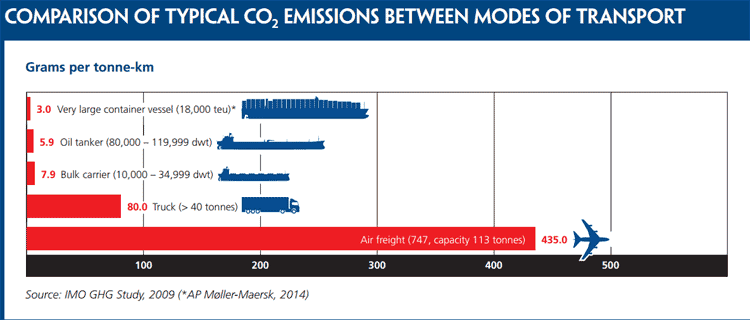Ocean shipping represents just 2-3% of current CO2 emissions, depending on the estimate, but it is increasingly under a microscope by environmentalists calling for the sector to reduce greenhouse gases.
That is in part because the ocean shipping industry - as well as the air sector - largely went unmentioned in the final accord in last year's UN climate summit, where a global agreement of sorts was reached that if individual countries keep their pledges will reduce CO2 somewhere to near safe levels, according to some climate models.
The International Maritime Organization (IMO), the U.N. agency responsible for regulating ocean shipping from ships, forecasts CO2 emissions from vessels will rise anywhere between 50% and 250% by 2050 in its "business as usual" case, as economies grow and trade increases.
It is not clear how the IMO would be able to enforce any rules promoting reduce CO2 from ocean ships on a global basis.
So far, specific targets to curb emissions growth have been blocked by emerging countries like India and Brazil, which expect their imports and exports to soar in coming years, and worry changes to rules could lead to much higher logistics costs that will impact their economies.
But some shipping companies, especially ones that have invested in newer, more fuel-efficient ships, say the IMO should take action to limit emissions, before regulation is imposed by regional blocs like the European Union or individual countries.
For example, the European Union tried several times to tax CO2 emissions from the use of jet fuel on flights into and out of Europe, with one proposal going so far as to the apply the tax on the total distance of the trip, not just the miles within EU airspace. The rules have been dropped under fierce protests from other nations, notably China, which said it simply would not pay the tax, but the idea is still out there.
The EU in recent years has also regularly floated proposals for rules applying carbon taxes on ocean shipping.
A session in late April of the IMO's Maritime Environment Protection Committee agreed only to defer further discussion on emissions to its next session in October. That will be the last chance to come up with targets before the next round of global climate talks, COP-22, the following month in Marakesh.
"The shipping industry cannot go to COP-22 in Morocco without this [a framework for CO2 reductions], said Alastair Fischbacher, head of the Sustainable Shipping Initiative, an industry association that promotes efficiency standards. "Not only will it damage the industry's reputation, it also runs the risk of external regulators taking the matter into their own hands and circumnavigating the IMO, which no-one in the industry wants to see."
The European Commission estimates that air and marine transport, which now jointly account for 5% of global emissions combined could contribute as much as a third of all emissions by 2050, as reductions in things like electricity generation take hold. Last month a group of European lawmakers urged the European Union to take tougher action on the two sectors.
"There is no reasonable excuse to continue exempting aviation and shipping from the international and EU climate policies," the lawmakers wrote. "Such growth (in emissions) will undermine reduction efforts by all countries and other sectors to limit warming to the 1.5/2°C agreed in Paris."
Last October, the European Commission called on the IMO to present measures to cut emissions by the end of 2016, which the shipping industry at the time said was "unrealistic."
Peter Hinchliffe, secretary general of the International Chamber of Shipping (ISC), which represents more than 80 percent of the world's merchant fleet, predicted the IMO would deliver a framework for CO2 cuts, but the question is when.
"It is the nature of international debate that sometimes it takes longer than some would wish," he said.
The reality is that not only does ocean shipping (bulk and container) account for the small 2-3% share of current CO2 emissions globally, it is also by far the most efficient transportation mode in terms of those emissions.
As shown in the chart below, produced a couple of years ago by the ISC, large container ships produce just 3 grams of CO2 per ton of freight moved one kilometer. That is a small fraction of the 80 grams per ton-kilometer from for heavy duty trucking, though of course the trucking sector is working hard to improve those numbers through increasing engine mileage, switching to natural gas trucks and other initiatives.

There are similar opportunities in the ocean shipping sector, with advances that will improve fuel efficiency, and nascent efforts to switch from traditional bunker fuel to natural gas power.
In addition, much of the total emissions from ocean shipping comes in fact from the shipping of oil from producing countries to consuming ones, so if other efforts are successful in reducing oil consumption generally, it would have the effect of also reducing CO2 from shipping the stuff around the globe.
Our Take: While every sector ought to do its share, with ocean shipping representing such a small percent of total emissions - and we find projections of a huge rise in its share exaggerated - combined with the fact it is so efficient compared to other modes that sanity will be maintained in balancing CO2 reductions with their impact on logistics costs.
What do you see as the tradeoffs beteeen CO2 reductions in ocean shipping versus increases in logistics costs? Let us know your thoughts at the Feedback button below.

|